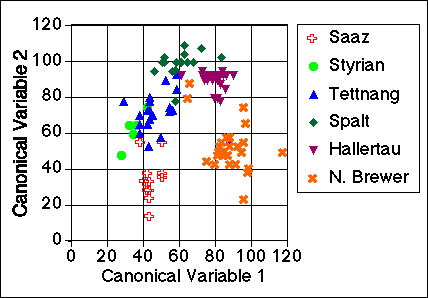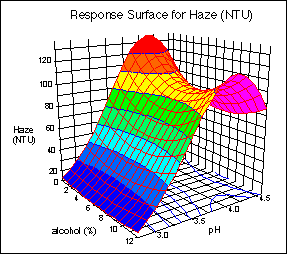Chemometrics & Multivariate Analysis
It is quite common today to collect data in which several or many measurements are performed on the same set of samples (e.g. multiple peaks in chromatography or measurements at numerous wavelengths in spectroscopy). In part, this reflects the growing appreciation that most food products and the perceptions of their properties are multivariate in nature. While multivariate measurements provide considerably more information, and often a better understanding of complicated systems, they also may make analysis of the data and extraction of the maximum amount of information more difficult. The application of mathematical and statistical methods to such data sets is called multivariate analysis or chemometrics.
Procedures in this area fall into two main areas – modeling and classification. Modeling is the collection of data in order to develop a formula that describes the behavior of a system (often called a response surface). Systems may be analytical methods, food products, unit operations or production processes. Once a formula has been obtained, the behavior of the system can be displayed graphically to aid in its understanding or to select an optimum combination of conditions. Often the data needed to construct a model are obtained using a statistically based experiment design to minimize the number of experiments needed while obtaining the most useful information.
Classification procedures, often called pattern recognition methods, are useful for discerning classification rules that characterize groups of samples. The rules indicate the particular sample measurements (often a small subset of the original measurements) that are most useful in determining group identity. Sample measurements may be used to classify samples according to their cultivar, to distinguish normal and abnormal products or to detect adulteration.

Program Activities and Outputs
M.C. Meilgaard and K.J. Siebert. 1981. Advanced methods of sensory evaluation. In European Brewery Convention Monograph VII, Flavor Symposium. Copenhagen. pp. 33-42. (data analysis). abstract
E.J. Knudson and K.J. Siebert. 1983. High performance liquid chromatographic analysis of hop bittering components in hops, hop extracts, wort and beer. J. Amer. Soc. Brew. Chem. 41(2): 51-57. (analytical method modeling and optimization) abstract
L.E. Stenroos and K.J. Siebert. 1984. Application of pattern-recognition techniques to the essential oil of hops. J. Amer. Soc. Brew. Chem. 42(2): 54-61. (cultivar classification by pattern recognition) abstract
K.J. Siebert and L.E. Stenroos. 1989. The use of multivariate analysis of beer aroma volatile compounds to discern brand-to-brand and plant-to-plant differences. J. Amer. Soc. Brew. Chem. 47: 93-101. (pattern recognition) abstract
T.L. Peppard, S.A. Ramus, C.A. Witt, and K.J. Siebert. 1989. Correlation of sensory and instrumental data in elucidating the effect of varietal differences on hop flavor in beer. J. Amer. Soc. Brew. Chem. 47(1): 18-26. (composition to property modeling) abstract
M. Mathai, K.J. Siebert, S.A. Siebert, R.A. Durst, and S.G. Reeves. 1998. Development of a signal measurement technique for application in multianalyte liposome immunomigration assays. Food and Agricultural Immunology, 10(3): 195-202. (multivariate calibration) abstract
K.J. Siebert. 1999. Modeling the flavor thresholds of organic acids in beer as a function of their molecular properties. Food Qual. & Pref. 10 (2): 129-137. (QSAR composition to property modeling) abstract
K.J. Siebert. 2001. Quantitative structure-activity relationship modeling of peptide and protein behavior as a function of amino acid composition. J. Agric. Food Chem. 49 (2): 851-858. (QSAR composition to property modeling) abstract
K.J. Siebert. 2001. Chemometrics in brewing – A review. J. Amer. Soc. Brew. Chem. 59 (4): 147-156. abstract
S. Carpino, T.E. Acree, D.M. Barbano, G. Licitra, and K.J. Siebert. 2002. Chemometric analysis of Ragusano cheese flavor. J. Agric. Food Chem. 50 (5): 1143-1149. (pattern recognition, modeling) abstract
K.J. Siebert, Symposium Organizer, “Chemometrics in Food Research”, presented at American Chemical Society Fall 2002 Meeting, Boston August 18-22 Symposium
Siebert, K.J. 2003. Modeling protein functional properties from amino acid composition. J. Agric. Food Chem. 51(26): 7792-7797. (QSAR composition to property modeling) abstract
Tan, Y. and Siebert, K.J. 2004. Quantitative Structure-Activity Relationship modeling of alcohol, ester, aldehyde and ketone flavor thresholds in beer from molecular features. J. Agric. Food Chem. 52 (10): 3057-3064. abstract
Siebert, K.J. 2005. Multivariate analysis of routine beer analysis results. J. Amer. Soc. Brew. Chem. 63 (3): 113-120. abstract
Donzelli, B.G.G., Siebert, K.J. and Harman, G.E. 2005. Response surface modeling of factors influencing the production of chitinolytic and beta-1,3-glucanolytic enzymes in Trichoderma atroviride strain P1. Enzyme & Micro. Tech. 37 (1): 82-92. abstract
Pryor, S.W., Siebert, K.J., Gibson, D.M., Gossett, J.M. and Walker, L.P. Modeling production of antifungal compounds and their role in biocontrol inhibitory activity. J. Agric. Food Chem. 55 (23): 9530-9536, 2007. abstract
Tan, Y. and Siebert, K.J. Modeling bovine serum albumin binding of flavor compounds (alcohols, aldehydes. esters and ketones) as a function of molecular properties. J. Food Sci. 73 (1): S56-S63, 2008. abstract
Nie, Lei and Siebert, K.J. Modeling physicochemical properties and activity of aspartyl proteinases based on amino acid composition. J. Agric. Food Chem. 57 (6): 2536-2543, 2009. abstract
Siebert K.J. Using chemometrics to classify samples and detect misrepresentation. Progress in Authentication of Food and Wine Ebeler, S.E., Takeoka, G.R. and Winterhalter, P., Eds. American Chemical Society, 2011, pp. 39-65. abstract
K.J. Siebert, Cornell Course – Food Science 6080: Chemometric Methods in Food Science. Presented alternate years – next offering Fall 2014 – course information

